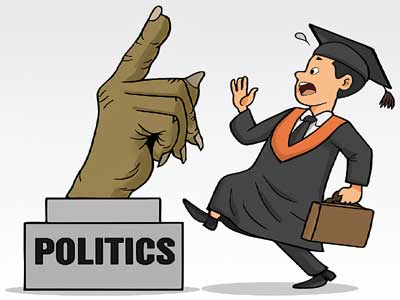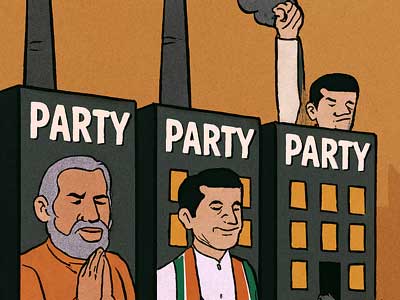You might have seen monkeys on trees and clowns in a circus taking amazing somersaults, but when the head of a global superpower apes his simian cousins and wows you with unexpected plunges and speedy back walking, the comity of nations can not but be alarmed.
In less than six months, this new White House tenant has demonstrated incredible flexibility and dexterous manoeuvrability in dealing with complex international issues, seemingly undeterred by image or trust deficit.
Read in Hindi: ट्रंप की नीतिगत कलाबाजियों से दुनिया में फैल रहा है भ्रम
In his second term, President Donald Trump has made headlines, not for consistent leadership, but for a bewildering series of policy reversals that have left global markets rattled and allies confused.
From unpredictable tariff threats to diplomatic flip-flops in global conflict zones, Trump’s approach reveals a pattern of impulsive declarations followed by quiet retreats, often without achieving any substantive goals.
Nowhere is this erraticism more visible than in his tariff policies. In late 2024, shortly after reclaiming the presidency, Trump stunned North American partners by threatening a sweeping 25 per cent tariff on all imports from Canada and Mexico. The rationale? Ongoing disputes over immigration and narcotics. Yet by March 2025, with no significant concessions from either neighbour, Trump paused the tariffs for 30 days, only to later suspend them altogether. The reversal, shared via cryptic social media posts, left analysts baffled and partners wary.
China wasn’t spared Trump’s protectionist zeal. He declared punitive tariffs on Chinese imports, asserting that countries that didn’t retaliate would be rewarded, while defiant ones like China would suffer. But in April, facing spiking bond yields and market turmoil, the administration issued a 90-day pause, even extending exemptions for Chinese electronics. It marked the latest in a series of nine flip-flops on China tariffs, ranging from bold proclamations of permanence to backdoor exemptions.
The European Union, too, found itself on the receiving end of Trump’s trademark bluster. On May 23, Trump threatened tariffs as high as 50 per cent on EU imports. The markets reacted swiftly, negatively. Within days, the administration reversed course, agreeing to extend trade talks without securing any concrete concessions. In fact, this ‘on-again, off-again’ behaviour was seen repeatedly, with April 8 marking yet another 90-day global pause on a slew of tariff hikes that had rattled business confidence worldwide.
Trump’s erratic trade policies had direct consequences for major corporations. Apple’s ambitious manufacturing expansion in India, for example, was severely disrupted by fears of 25 per cent tariffs on iPhones. IPOs were delayed, deals suspended, and CEOs left in a fog of uncertainty.
The pattern extended well beyond trade. Trump’s foreign policy in 2025 has often resembled a reality television script, characterised by dramatic threats, swift pivots, and no clear resolution. In West Asia, the administration’s posture zigzagged from isolating Syria to lifting sanctions and praising its interim leader, despite the individual’s links to former Al-Qaeda factions. At the same time, Trump alienated traditional allies like Israel during a Gulf tour aimed at securing $2 trillion in investment deals. His so-called ‘realist’ rhetoric masked a string of opportunistic, short-term manoeuvres that eroded US credibility.
On Iran, Trump threatened bombing raids in April 2025, heightening fears of another Middle Eastern conflict. But no military action followed, and the threat quietly disappeared from public discourse. Meanwhile, a contradictory olive branch was extended to Tehran even as ‘maximum pressure’ rhetoric continued unabated.
His Ukraine policy followed a similarly muddled script. Initially condemning Putin’s aggression as ‘crazy’, Trump vowed sanctions if Russia ignored ceasefire demands. But when Moscow failed to comply, no sanctions materialised. Ukrainian President Volodymyr Zelenskyy's appeals went unanswered, raising questions about America’s commitment to global security under Trump’s transactional leadership.
Trump's diplomatic theatrics reached absurd heights in his 2025 State of the Union address, where he demanded that Greenland be annexed by the United States. Later that year, he insisted Canada cede the Great Lakes—proposals that provoked both laughter and concern among policymakers worldwide. Unsurprisingly, neither demand progressed beyond rhetoric.
In March, Trump demanded Hamas release all hostages, implying severe consequences if ignored. As with other threats, no action followed, reinforcing the perception of an administration that postures boldly but seldom follows through.
Analysts have noted that Trump’s reversals often coincide with market instability. The April 2025 tariff pause, for instance, came directly after sharp stock drops and climbing bond yields. His Posts indicate a pattern in which Trump ‘blinks’ after triggering economic or geopolitical tension, then frames the retreat as part of a master strategy, despite the absence of any real diplomatic or trade gains.
Trump’s supporters argue this style reflects a tough negotiator unafraid to test boundaries. But critics—and many global leaders—see it differently: a chaotic governance model that prioritises headlines over outcomes and leaves America’s allies guessing.
Indeed, Trump’s leadership continues to defy prediction. What remains clear is that his somersaults—on tariffs, diplomacy, and military threats—have not only sown confusion but may have fundamentally altered how the world engages with a volatile United States.


















Related Items
Path to a self-reliant India amid global trade conflicts…
Trump’s Conspiracy: India’s Trap or Golden Opportunity?
Trump’s U-Turn and strategic realities of India-US relations